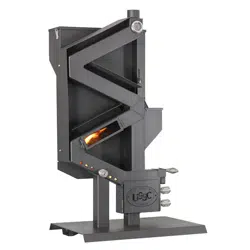Loading ...
Loading ...
Loading ...

14
© 2021 United States Stove Company
adjustment can result in a drastic temperature change.
Narrowing will slow the pellet feed rate resulting in lower
running temperature. Widening will result in an increased
pellet feed rate resulting in a higher running temperature.
HELPFUL HINTS
• Starting the draft by letting the handheld torch run
for one minute before introducing pellets is highly
recommended. When the stove is cold and it is colder
outside than it is inside, there is a downward draft in
the chimney. Running the torch for one minute first will
overcome this downward draft that is present.
• If smoke becomes present during ignition, reposition
the torch head so the flame is burning across the
bottom of the burn basket not directly on it.
• The secondary burn plate can be slid out up to one inch
to provide maximum airflow during operation.
• While operating the stove on low (damper holes open)
the temperature gauge should never fall below 300°.
Two things happen when the stove falls below 300°.
1) The draft will slow down enough to impede the
performance of the stove. 2) Creosote will build up
causing poor performance and increase the risk of a
flue fire.
• If it was necessary to adjust the primary burn basket
wider, it may be necessary to clear the secondary burn
plate more often during operation.
• A barometric damper will help solve problems when
the stove is experiencing constant high heat output.
Barometric gives the user the ability to regulate draft
through the chimney until desired temperatures are
established on the appliance it has been installed on.
• A VacuStack chimney cap is recommended when
experiencing draft issues or fluctuating temperatures
or low heat output. VacuStack caps are designed to
increase draft on any chimney by causing a vacuum
eect through the flue below when the air moves past
the cap.
• CAUTION: In high wind areas, excessive draft can be
experienced resulting in extended high-temperature
output on the stove. We recommend a barometric
damper be installed when this occurs which gives you
the ability to control the excessive draft created by the
vacustack and persistent wind currents above.
• Remedies for those that experience a temperature
drop after several hours of operation: First, dump the
ashtray and properly dispose of ashes as described in
this manual. Second, clear the secondary burn plate
as described in this manual. If this does not bring the
temperature back up then close the pellet stop plate for
approximately 35 minutes running the stove on high.
Reopen the pellet stop plate. This clears the vertical
feed tube of any pre-heated pellets and reintroduces
fresh pellet fuel.
REFUELLING
CAUTION:
• THE HOPPER AND STOVE WILL BE HOT
DURING OPERATION; THEREFORE, YOU
SHOULD ALWAYS USE SOME TYPE OF HAND
PROTECTION WHEN REFUELING YOUR STOVE.
• DO NOT TOUCH THE HOT SURFACES OF THE
STOVE. EDUCATE ALL CHILDREN ON THE
DANGERS OF A HIGH-TEMPERATURE STOVE.
YOUNG CHILDREN SHOULD BE SUPERVISED
WHEN THEY ARE IN THE SAME ROOM AS THE
STOVE.
• WE RECOMMEND THAT YOU NOT LET THE
HOPPER DROP BELOW 1/4 FULL.
WARNING:
• KEEP HOPPER LID CLOSED AT ALL TIMES
EXCEPT WHEN REFILLING.
• DO NOT OVERFILL HOPPER.
TAMPER WARNING
This wood heater has a manufacturer-set minimum
burn rate that must not be altered. It is against federal
regulations to alter this setting or otherwise operate this
wood heater in a manner inconsistent with operating
instructions in this manual.
SHUTTING DOWN THE STOVE
When you are ready to shut your stove down simply
close the pellet feed door (move to the down position).
After you have closed the pellet feed door the stove will
continue to run for approximately 45 minutes. When
shutting down the stove make sure to close the draft slide
(holes blocked).
OPERATION INSTRUCTIONS
Loading ...
Loading ...
Loading ...
